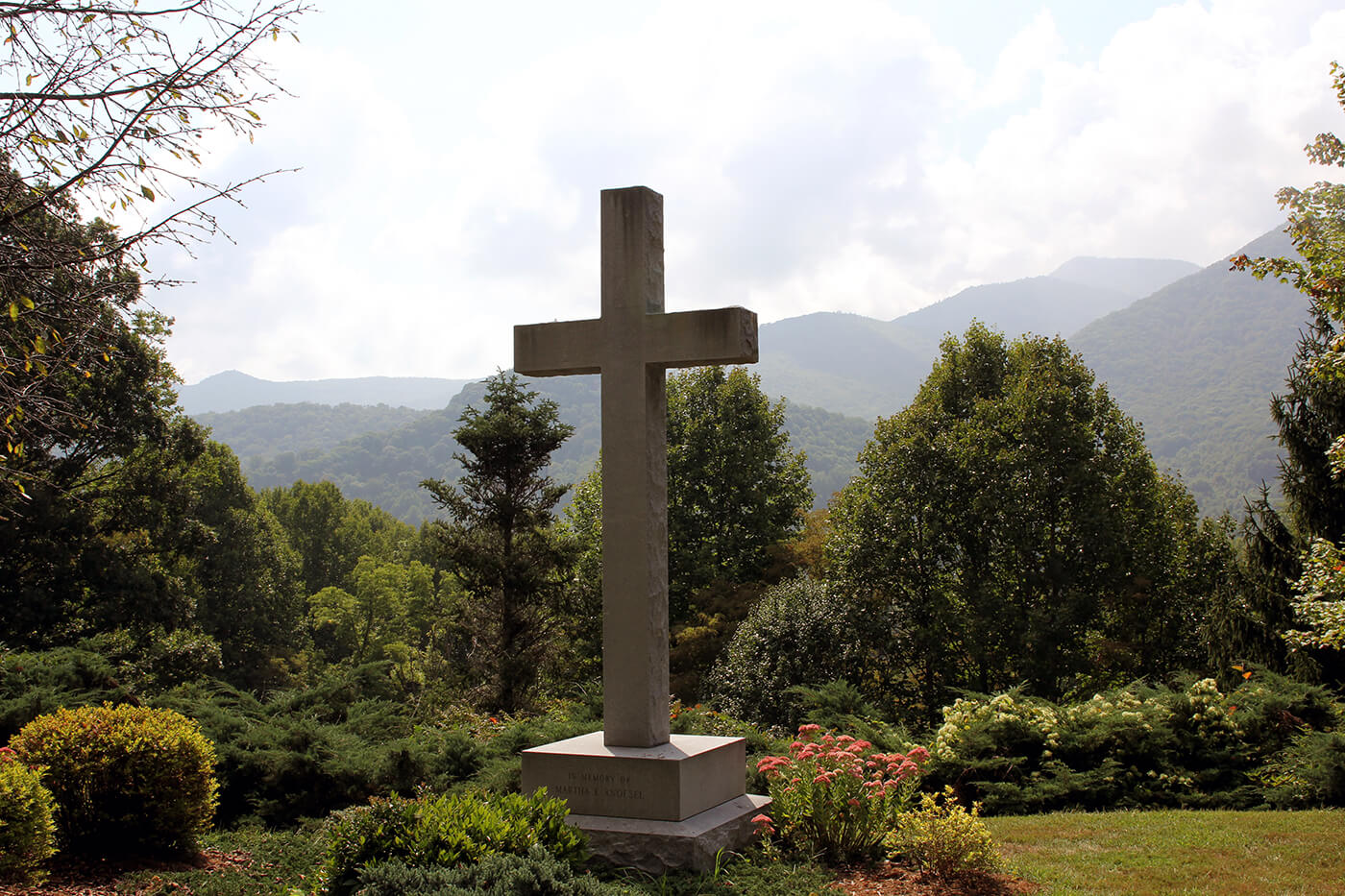A story of perseverance, priests on horseback, and growth in numbers and in faith
With more than half a million Catholics, the Diocese of Charlotte may be only 50 years old but the roots of Catholicism in western North Carolina run much deeper – from colonists who came from Europe to the “New World” in search of freedom and adventure, to Benedictine monks who helped nurture Catholicism in western North Carolina in the late 1800s.
From our earliest days, growth has been our defining narrative – in numbers, in diversity and in faith.
With God’s grace, the Church in western North Carolina now encompasses 92 parishes and missions, 19 schools and more than 50 ministries and programs. But our story begins in more sparse and humble circumstances met with the perseverance and faith of pioneering Catholics.
While the faith was introduced to the Americas by Spanish and French colonists, the founding of the Province of Maryland in 1632 is generally considered the birth of Catholicism in English-speaking America.
During the Revolutionary period, the 35,000 Catholics in the colonies looked to Church leaders in England until 1784 when Pope Pius VI established a hierarchy here, installing Father John Carroll as “Superior of the Missions” in the United States.
Five years later, the Diocese of Baltimore was created and responsible for governing and growing the Church across the fledgling country. Then came the Diocese of Charleston in 1820, which comprised the sparsely populated, mostly wilderness area of three states: Georgia, South Carolina and North Carolina.
Priests on horseback
A handful of priests “rode the circuit” back then to reach the few Catholics scattered across 142,000 square miles, saying Mass and administering the sacraments in private homes. The diocese then had just two churches and six priests.
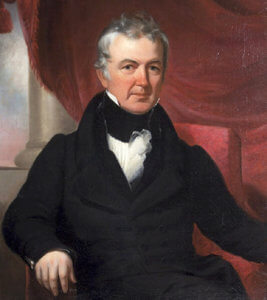
William Gaston
Catholics were often treated with hostility, in a land where Protestantism reigned. But in 1835, William Gaston – a much-respected North Carolina Catholic who served as judge, state legislator and Congressman – helped remove official discrimination against Catholics from the North Carolina Constitution.
At the same time, more Catholics began putting down roots in the Carolinas: mostly Irish stonemasons and tradesmen who found work with the railroads, in construction and in mines – where prospectors had struck gold.
In 1843 Irish miners, who had come to search for gold along the Catawba River, built St. Joseph Church near Mount Holly – the first Catholic church west of Raleigh. Now a state and national historic site, this humble wooden church still stands today, thanks to the sacrifices of those early Catholic families.
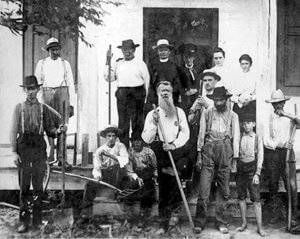
Irish immigrants outside Old St. Joseph Church, Mount Holly
Father Jeremiah O’Connell was among a handful of trailblazing missionary priests who ministered to the few hundred Catholic families living in here, traveling tirelessly across the three-state diocese. In 1851, O’Connell rode three days by stagecoach from Charleston to lay the cornerstone of St. Peter in Charlotte – now the oldest continuously active Catholic parish in our diocese.
During his travels, O’Connell realized the need for a Catholic college and seminary to educate people and nurture vocations to the priesthood – a dream, with God’s grace, that would soon come true.
A Catholic college
As the South began its recovery from the Civil War, Pope Pius IX established the “Apostolic Vicariate of North Carolina” in 1868, a jurisdictional territory initiated in missionary regions. Bishop James Gibbons, who would later become the first cardinal in the U.S., was appointed to lead the Church across North Carolina as apostolic vicar.

Fr. J.J. O’Connell
O’Connell, the traveling priest, approached Gibbons with a pitch. At a bankruptcy sale, O’Connell had made the buy of a lifetime: 500 acres of farmland near what now is the town of Belmont, N.C. – for $10. He offered to donate the land if Gibbons would agree to use it for a Catholic college for young men run by religious order.
Also well aware of the need for religious education, Gibbons petitioned St. Vincent’s Archabbey in Latrobe, Pa., to form a community of Benedictine monks and a college on the land.
In 1876, the first Benedictines and their students arrived. Besides their religious studies and missionary work, the monks made the bricks used to build the abbey. Within two years there were 12 students and four faculty, and in 1886, the college was chartered by the state as St. Mary’s College. (The name changed in 1913 to Belmont Abbey College.)
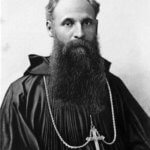
Abbot Leo Haid, OSB
In 1884, Pope Leo XIII elevated the Benedictine priory to an abbey. Father Leo Haid was elected as the first abbot of the growing community and soon also was appointed Apostolic Vicar of North Carolina — making him responsible for the Church across the state while also sending out monks from the Abbey to say Mass and administer the sacraments to far-flung communities of Catholics.
Diocese of Raleigh
Like the circuit-riding priests before them, the Benedictine monks had a pioneering spirit and unwavering missionary zeal. Together with the Sisters of Mercy, who arrived in the 1880s, they established parishes and parochial schools, girls’ boarding schools in Belmont and Asheville, and hospitals in Asheville, Charlotte and Greensboro.
From the 1880s to the 1920s, North Carolina’s Catholic population tripled to more than 8,000 people – served by 52 priests. This growth prompted Pope Pius XI to make North Carolina a diocese in its own right in 1924.
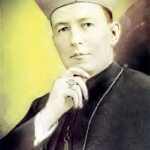
Bishop William Hafey
The new Diocese of Raleigh encompassed the entire state, except for a limited territory governed by Belmont Abbey. Its first bishop: William Joseph Hafey from Baltimore; at 37, then the youngest bishop in the U.S.
Through the early to mid-20th century, the number of white and black Catholic families continued to grow. Home Masses – the norm in those early years – continued even as more churches and schools were built.
One of those new churches was St. Patrick Catholic Church in Charlotte. Built by local Irish families in 1939, years later it would become the cathedral for the Diocese of Charlotte.
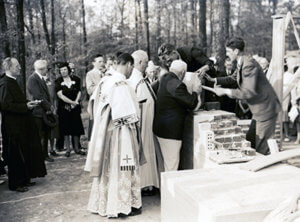
Cornerstone laid at St. Patrick Church, Charlotte, 1939
The statewide Diocese of Raleigh gradually absorbed nearly all of the territory governed by Belmont Abbey, as popes transferred Burke, Catawba, Cleveland, Lincoln, McDowell, Polk and Rutherford counties in 1944 and Gaston County in 1960.
Diocese of Charlotte
By 1971, Raleigh’s visionary Bishop Vincent Waters realized the Church in North Carolina had grown too large for him to shepherd alone. With over 60,000 Catholics spread across nearly 50,000 square miles, it was time to split North Carolina into two dioceses – putting each “on a human scale” as called for by the Second Vatican Council. Pope Paul XI agreed, issuing an apostolic letter, “Qui divino,” in November of 1971, decreeing the establishment of a new diocese.
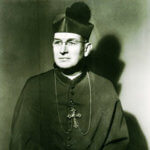
Bishop Vincent Waters
“When the family of God grows and matures in any place, in the plan of God a new family is set up,” Bishop Waters wrote in his pastoral letter announcing the new diocese on Nov. 30, 1971. “Rejoice with me at this Good News.”
Just six weeks later, on Jan. 12, 1972, the Diocese of Charlotte was officially founded, with just over 34,000 Catholics in 75 parishes and covering the western half of the state.
Monsignor Michael Begley, a Greensboro priest, was consecrated the first bishop during an installation Mass at the newly elevated St. Patrick Cathedral. The next morning, “we were open for business,” Begley later recalled.
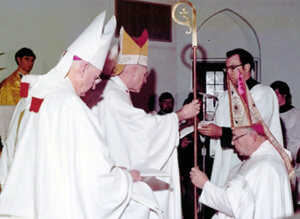
Newly consecrated Bishop Michael Begley receiving his crozier, 1972
Begley’s appointment was a sign of God’s providence. The son of an Irish immigrant himself, he was also distantly related to Bishop Hafey – the first bishop of North Carolina.
Begley led the new diocese through its formative years with wisdom and pragmatism, establishing the foundational ministries and structures for the diocese and its 75 parishes and missions. His work on behalf of the Appalachian poor gained national attention for the plight of those in remote reaches of the diocese.
In 1977, Pope Paul VI transferred authority for the remaining territory of Belmont Abbey to the jurisdiction of the Diocese of Charlotte, establishing its current configuration. (Belmont Abbey had existed as an “Abbatia Nullius Dioecesis” (“abbey of no diocese”) since 1910 – the only abbey in the United States ever to hold that rank. In 1998, the Abbey was elevated to the rank of a minor basilica – the second church to be so honored after St. Lawrence Church in Asheville, also a treasure of the Charlotte diocese.)
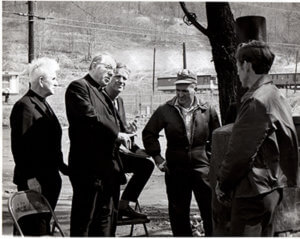
Bishop Begley talking to Appalachian miners
Narrative of Growth
Bishop Begley served until his retirement in 1984. Since then, Diocese of Charlotte has had three bishops, all appointed by Pope John Paul II:
- Bishop John Donoghue, 1984-1993, who had the vision to buy land for future growth, and to lead a Synod in 1987 that would guide the diocese for years to come. Read more
- Bishop William Curlin, 1994-2002, who called attention to North Carolina’s economic disparities, founded the diocese’s affordable housing initiative, and showed a special love for ministry to the elderly, sick and dying. Read more
- Bishop Peter Jugis, our current and longest-serving bishop appointed in 2003, who has led the diocese through significant multicultural growth and modern complexities. Read more
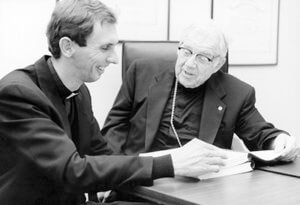
Bishop Begley and then Father Peter Jugis
Baptized and mentored by Begley, Jugis is the first native son to serve as bishop of the Charlotte diocese – fulfilling the hopes of those pioneering missionaries long ago who prayed for local vocations to build up the Church in North Carolina.
And what a growing, vibrant and diverse family the diocese is today.
Just as the Church reached out to Irish immigrants in earlier times, the diocese now embraces many new immigrant groups: Catholics from Mexico, Central and South America, Southeast Asia, Eastern Europe, Lebanon, India and Africa.
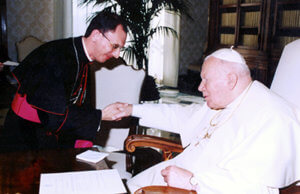
Newly consecrated Bishop Jugis meets with Pope John Paul II, 2004. The pope had ordained him to the priesthood in 1983 and, 20 years later, appointed him bishop.
In total, our diocesan family totals more than 500,000 people, spread across 46 counties in 92 parishes and missions.
Among the diocese’s 50 ministries and programs are food banks, counseling, affordable housing, prison ministry, youth and elder ministry, campus ministry, anti-poverty efforts, refugee resettlement, teen pregnancy support, pro-life advocacy, and now a Family Life Office, to deepen support for families who have made the diocese what it is today.
The number of priests has grown, too: nearly double the number at our founding in 1972. And the diocese is forming a new generation of priests right here at home.
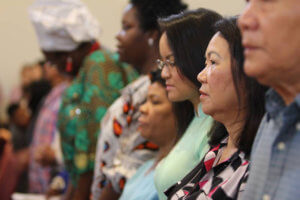
Parishioners at St. Mary’s Church, Greensboro
That initiative is among Bishop Jugis’ top priorities. He established St. Joseph College Seminary in 2016, with an inaugural class of eight young men from the diocese who could pray and learn more about becoming a priest while also attending Belmont Abbey College.
In 2020, the diocese opened a permanent home for the thriving college seminary, now with 24 students in the program. Located in Mount Holly, the seminary is not far from where those early pioneers built Old St. Joseph Church and Belmont Abbey – where Catholicism first took root in western North Carolina.

St. Joseph College Seminary opens, 2020
Ever diverse and growing, the Diocese of Charlotte remains grounded in faith in God – and nowhere is this more on display than at the annual Eucharistic Congress. Each fall thousands of Catholics from across western North Carolina gather for this “diocesan family reunion.” Started by Bishop Jugis in 2005, the event includes a stirring Eucharistic procession, Mass and Adoration, educational talks, music and multicultural fellowship. Above all, the gathering expresses our love for the Eucharist – the source and summit of our Catholic faith.
In 2022, as we celebrate the 50th anniversary of our founding as a diocese, this year’s Eucharist Congress will highlight our faith and devotion to God and give thanks to Him for all the faithful who came before us to make this milestone possible. Please join us for the celebration Aug. 5-6 at the Charlotte Convention Center.
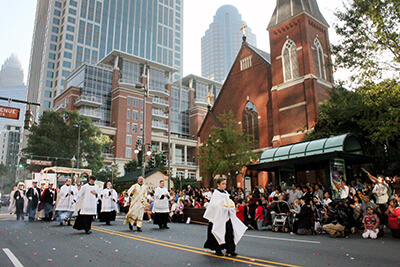
Eucharistic Congress Procession, Charlotte

